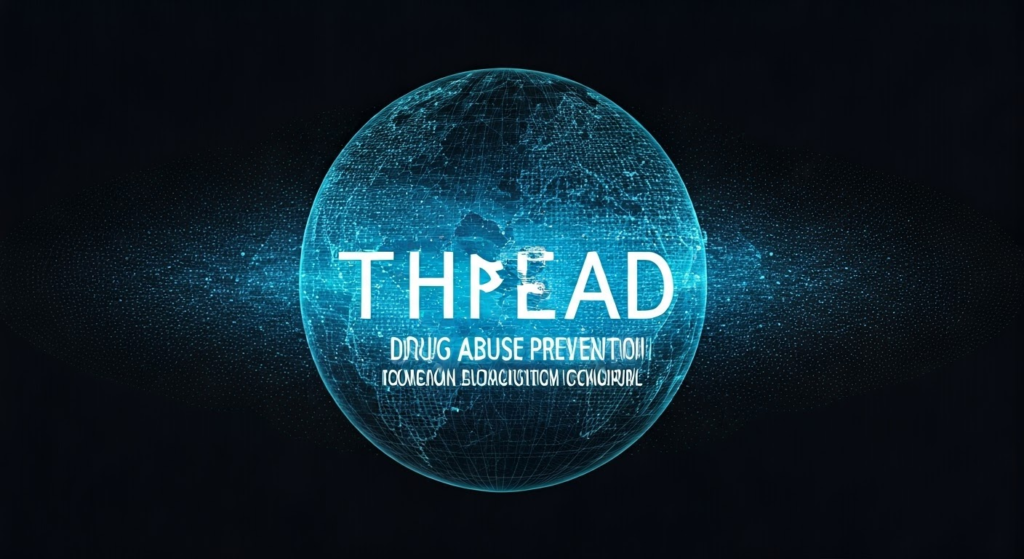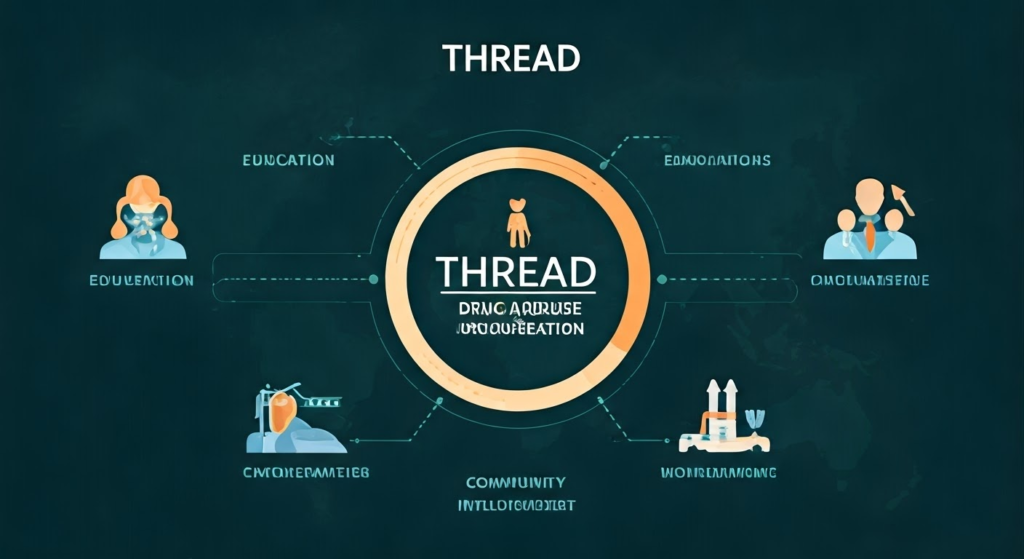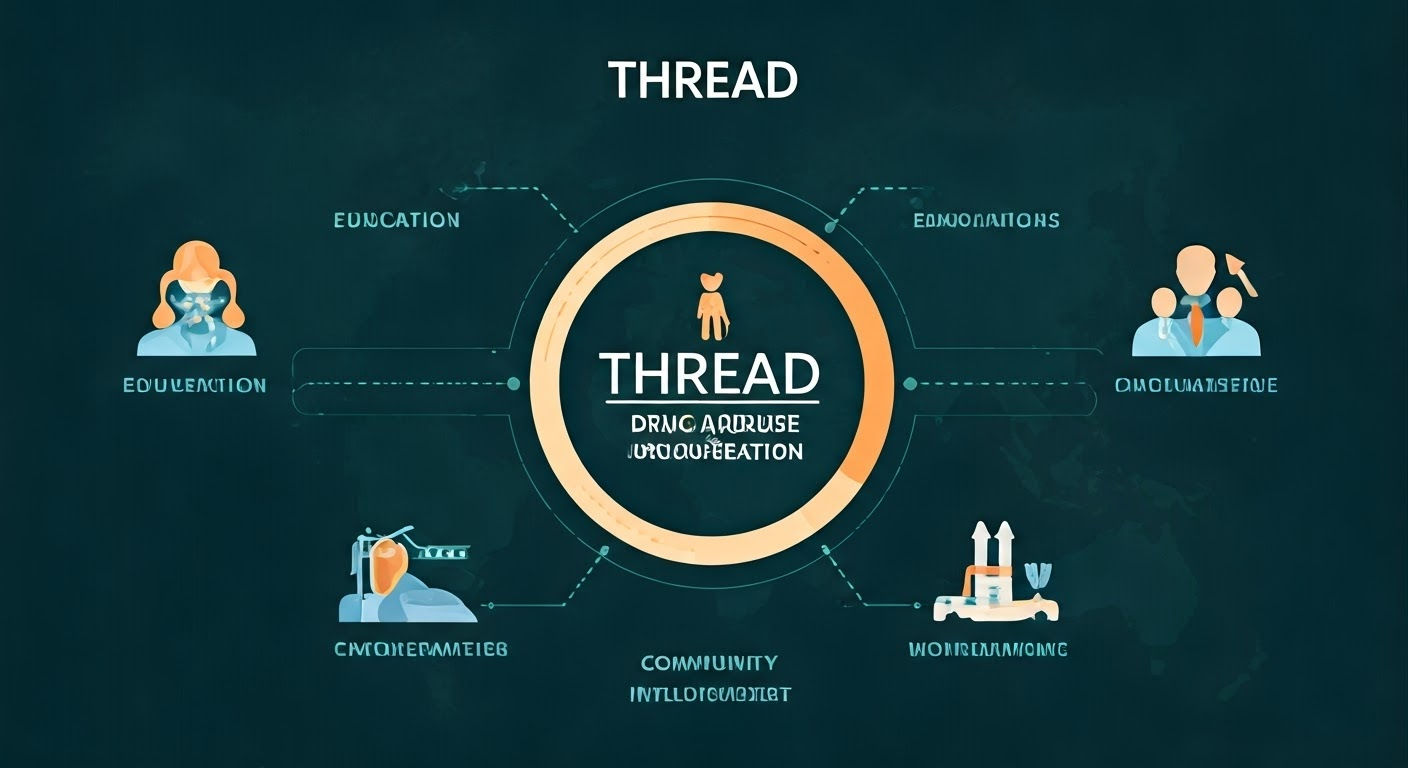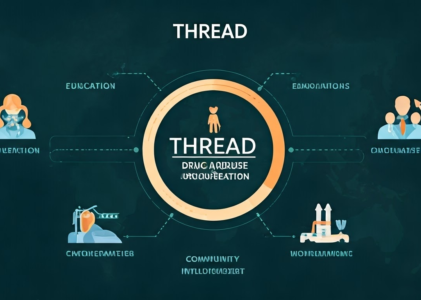Understanding THREAD Drug Abuse Prevention

Key Highlights
- THREAD emphasizes early intervention and understanding the multifaceted nature of drug abuse.
- Identifying risk factors like environmental influences, genetic predispositions, and mental health is important for effective prevention.
- Education plays a crucial role, involving schools, parents, and communities in promoting awareness and healthy coping mechanisms.
- Support networks, community engagement, and breaking down stigma are essential for creating a safety net for vulnerable individuals.
- The latest innovations in addiction treatment focus on leveraging technology for better outreach and exploring new therapeutic approaches.
- Understanding the legal and policy landscape surrounding drug abuse is crucial for informed prevention and intervention efforts.
Introduction
Drug addiction, also called substance use disorder, is a complicated problem involving alcohol addiction. To prevent it, we need to look at different parts of the issue. This includes psychological factors, social influences, and personal weaknesses. To tackle this problem effectively, the whole community must work together. This means we should focus on education, building support systems, and making treatment options easily accessible.
The Basics of THREAD Drug Abuse Prevention

THREAD takes a complete look at preventing drug abuse. It does not just see addiction as a personal problem. Instead, it recognizes that many risk factors interact with each other. This way of thinking highlights how important it is to find and address problems early, as effective treatment requires early intervention. Tackling issues in the beginning can help stop substance use disorder from developing later on.
At the heart of THREAD is the idea that prevention needs to fit different situations. There is no single way to handle this issue. Strategies should be designed to fit the unique needs of different communities and people. This includes looking at cultural backgrounds and economic conditions. This approach also encourages teamwork. Families, teachers, healthcare workers, and government officials must join forces to effectively fight against drug abuse.
Defining THREAD in the Context of Drug Abuse
THREAD represents the many links that can lead to addiction. It shows that addiction is complex, not something simple to explain. Each letter in THREAD stands for an important part: Triggers, Heredity, Environment, Awareness, Determination, and Support. This view understands that addiction comes from various causes, not just one.
THREAD also highlights how people deal with their problems. It shows that substance abuse can be a misguided way to handle stress, trauma, or mental health issues. By looking at these links, we can work on prevention by helping individuals find better ways to cope and build resilience.
In short, THREAD aims to simplify the complicated issues around drug abuse. It moves away from blaming individuals and instead promotes understanding. This approach encourages early intervention by tackling the root causes of substance abuse, along with its symptoms.
The Importance of Early Prevention
Early prevention of drug abuse is very important, especially for children and teens. This time is when their brains grow a lot, making them more open to outside influences. By acting early, we can help young people learn what they need to know and build skills to make healthier choices and avoid substance use.
Prevention strategies look for risk factors like a family history of addiction, trauma, or mental health issues. By spotting these risks, we can help in time, giving young people the support and resources they need to lower risks and build strength.
Also, early prevention works to create protective factors that help prevent drug abuse. This includes building strong family connections, encouraging good friendships, and supporting positive social activities. By promoting these protective factors, we can help young people live healthy and fulfilling lives without addiction.
Identifying Risk Factors for Drug Abuse
Understanding the risk factors linked with drug abuse, including sexual abuse, is important for good prevention and help efforts. These factors can come from personal issues or things around us. They increase the chance of substance use. By knowing and tackling these risk factors, we can create better prevention programs. We can also offer the right support to people who might need it.
It is important to note that having risk factors does not mean someone will abuse drugs. They only make it more likely. This shows how necessary it is to have a complete prevention plan. Such a plan should think about how different factors work together. Spotting issues early and using the right help can greatly lower these risks. It can also help people make better choices for their health.
Environmental Influences
Environmental factors are very important in how someone may become addicted to drugs. The family environment can greatly affect a person’s use of substances. When a home is filled with conflict, neglect, or physical abuse, it can lead individuals to seek comfort in drugs or alcohol. On the other hand, a caring and supportive family can help protect against these risks.
Peer pressure is another strong environmental factor, especially during the teenage years. Young people often want to fit in and be accepted. This can push them to engage in dangerous behaviors, like using substances. It’s vital to teach young people how to resist negative peer pressure and make healthy choices.
Additionally, communities that face poverty, easy access to drugs, or high rates of crime may make drug use seem normal. This poses real challenges for prevention efforts. Community programs that encourage positive social activities, create safe spaces for youth, and offer new opportunities are crucial to countering these harmful environmental influences.
Genetic and Biological Factors
Environmental factors are a big part of why drug abuse happens. However, genetic and biological factors are important too. Research shows that some people may be more likely to become addicted due to their genes. Certain genes change how the brain reacts to drugs, making some people more open to getting hooked on them. Knowing about these genetic factors is key for creating personalized addiction treatment plans.
Also, mental health issues like depression and anxiety often go hand in hand with substance abuse. People who have these mental health problems may use drugs or alcohol to help relieve their symptoms. But this can make their condition worse and increase the risk of addiction.
It’s important to understand how genetics and mental health work together to help prevent drug abuse. Treatment that combines care for addiction with support for mental health issues is vital for long-term recovery. Getting help early, with both medical and therapy options, can greatly improve a person’s chance of beating addiction.
The Role of Education in Preventing Drug Abuse

Education is key to preventing drug abuse. It helps people learn to make smart choices for their health. These efforts should start early, mainly in schools. They should also be present throughout life, reaching people through different community groups. Good education is more than just listing the dangers of drugs and alcohol.
It needs to look at the social and emotional reasons that lead to substance abuse, including alcohol abuse. Young people should gain skills to think critically about the different pressures they face. They need to learn how to make healthy choices. Talking openly about the dangers and effects of drug use is very important. Providing help for those who need it creates a supportive and informed atmosphere.
Implementing Effective School-Based Programs
Schools are great places for drug abuse prevention programs. They help reach young people before they start using substances. These programs should fit different age groups. They should use easy-to-understand language and methods to share important information. Fun activities, role-playing, and open talks work better with students than traditional lectures.
These programs should do more than just teach about the physical and social effects of substance abuse. They also need to give students important life skills. Building self-esteem, healthy ways to cope with stress, and good decision-making are vital for stopping drug abuse. Schools can involve parents and guardians by holding workshops and information sessions. This helps create a united effort against substance abuse.
Adding peer support groups and mentorship programs can make these efforts even stronger. Young people often listen better to messages from their peers. These programs can help reduce the stigma around mental health and substance abuse. This way, students feel more comfortable seeking help without worrying about being judged.
Educating Parents and Guardians
Parental guidance is very important in stopping drug abuse. When we give parents and guardians the right information and tools, they can create a safe place for their kids. Offering workshops and programs just for parents can help them learn how to talk to their children about substance use and its risks in an age-appropriate way.
Knowing the early signs of drug abuse is key. This includes watching for changes in behavior, school performance, friendships, and looks. It’s also important to teach parents how to communicate well. When parents create an open and trusting space, kids feel safe to talk about their problems and worries, which can lead to getting help early.
Additionally, parents should be good role models. Children learn a lot from watching adults. So if parents show responsible drinking and stay away from drugs, it sends a strong message. A home that encourages healthy activities, open talks, and strong family relationships can help kids stay away from substance use.
Community Engagement and Support Systems

Combating drug abuse needs a complete approach. It should go beyond just helping one person. Getting the community involved and providing strong support systems are very important. These elements help create a space where people at risk feel supported. They are also more likely to ask for help. This means providing easy access to resources, like counseling centers, support groups, and treatment facilities in the community.
Another key part is breaking down the stigma around addiction. Talking about substance abuse as a public health issue helps people be more understanding and empathetic. This creates a safe place for individuals to ask for help without fear of being judged. It helps build a community that supports those struggling with drug abuse and their path to recovery.
Building Strong Support Networks
Building strong support networks in a community is like creating a safety net. This net helps protect people who might fall into substance abuse. It takes teamwork to make this happen. Community resources like healthcare providers, teachers, police, and faith groups need to come together.
A key part of this is raising awareness about the services available and how to use them. Community outreach programs, public service messages, and social media can spread this important information. This ensures that it reaches the right people who need it the most.
One of the most important ways to build these support networks is by reducing the stigma around drug addiction. Discussing substance abuse as a medical condition instead of a moral failure helps people understand better. When we talk about it openly, we create empathy in the community. This mindset change encourages people who struggle with addiction to seek help. They can feel safe knowing that their community will support them in their recovery journey.
Success Stories of Community Intervention
Success stories of community intervention show us the hope that comes from working together to fight drug abuse. These stories help us see how important it is to create treatment options that fit the needs of different communities and groups.
One example might be a rural community where people worked together to lower opioid addiction rates. They did this by starting prevention programs in schools, setting up local support groups for those in recovery, and teaming up with healthcare providers to make medication-assisted treatment easier to access.
Another story could be about a community-driven effort to help with methamphetamine addiction in a busy city. They might have created needle exchange programs, made mental health services easier to reach, and offered job training and help with finding work. These actions can lead to positive changes and show how powerful community efforts can be.
Understanding the Psychology Behind Addiction
Drug addiction is not just a lack of willpower or a moral issue. It is a long-lasting disease that often comes back, affecting how the brain’s reward system works and how it reacts to pleasurable substances in an addicted person. Using drugs repeatedly can change brain chemistry. This can lead to strong cravings and compulsive actions, which result in addiction.
It’s important to understand the mindset behind addiction. This knowledge helps in creating better ways to prevent and treat the problem. Recognizing that addiction is a disease can help stop the shame around substance use disorder. It can also lead to a kinder way of helping people recover.
The Brain’s Response to Drugs
Drug use affects the way our brains work, especially the reward system. When we do things that make us happy, like spending time with family, enjoying good food, or completing tough tasks, our brain releases dopamine. This is a chemical that makes us feel pleasure and happiness. The release of dopamine encourages us to do those enjoyable things again.
However, using drugs upsets this balance. Drugs like opioids, cocaine, or methamphetamine release a lot of dopamine in the brain all at once. This creates a strong and euphoric feeling, which drives people to use drugs more.
As time goes on and drugs are used repeatedly, the brain changes. It starts making less dopamine naturally and doesn’t respond to it as well. Because of this, a person has to use more of the drug to feel the same high. This leads to a growing tolerance and dependence, which are signs of addiction. This stubborn cycle of craving, drug use, and brain changes shows how strong addiction can be.
Overcoming Psychological Triggers
Triggers are like unseen strings that can disrupt a person’s hard-fought sobriety. They can be sounds, sights, people, places, or even certain dates that cause cravings and raise the chance of a relapse. What triggers someone can be different from person to person, depending on their personal experiences and history with substance use. For instance, someone who had issues with alcohol may feel a strong urge when they see or smell beer, hear music from bars, or even feel lonely—the same feelings they used to escape with alcohol.
To handle these challenges, you need a solid plan. Cognitive Behavioral Therapy (CBT) has shown to be very helpful for people to spot their triggers. It helps them understand the thoughts and feelings tied to these triggers and teaches better ways to cope with urges to prevent a relapse.
This may include learning to relax with techniques like deep breathing or meditation. Staying active with regular exercise helps reduce stress. People might also find healthier ways to deal with strong emotions, such as journaling or talking with a therapist. Support from friends or family can be vital too. The main goal is to change harmful behaviors into positive ones that support lasting recovery and mental health.
Innovations in Drug Abuse Prevention
The way we prevent drug abuse is always changing. This is due to new technology, better knowledge of addiction, and fresh ideas for therapy and recovery. Traditional methods do not always work, so researchers and healthcare workers are trying hard to create new and better ways to tackle this complex problem.
They use technology to connect with people in their daily lives. They also explore new treatment options that tackle the root causes of addiction. These new ideas bring hope for better ways to prevent and treat addiction, which means healthier people, stronger families, and safer communities.
Leveraging Technology for Better Outreach
In today’s digital world, technology is very important for preventing addiction. It offers new ways to reach out, provide easy-to-access resources, and connect with people who may need help. Social media, mobile apps, and online communities help spread information about drug abuse. They also promote awareness campaigns and link people with local resources, such as support groups and treatment centers.
Telehealth services are another great example of how technology can help. They make it easier for people, especially in rural or underserved areas, to get care. Through secure video calls, individuals can meet with healthcare experts to receive counseling, therapy, and medication management—services they may not be able to find otherwise.
Also, virtual reality (VR) technology is becoming a helpful tool for preventing and treating addiction. VR programs can create real-life situations that trigger cravings. This allows individuals to practice coping skills and learn how to avoid relapsing in a safe space. By facing triggers in a virtual world, people can gain the skills they need to handle tough moments in real life and stay sober.
New Approaches in Therapy and Rehabilitation
Beyond traditional talk therapy and 12-step programs, the field of addiction treatment continually embraces innovative approaches that address the complex psychological, social, and biological underpinnings of substance use disorder. These innovative treatments recognize that a one-size-fits-all model is insufficient and strive to provide personalized care tailored to the individual’s unique needs and circumstances.
Emerging therapeutic approaches often integrate elements of mindfulness, meditation, and alternative therapies like yoga and art therapy into treatment plans. These practices help individuals manage stress, regulate emotions, develop healthier coping mechanisms, and reconnect with their inner selves—essential aspects of long-term recovery.
Below is a table highlighting a few innovative therapies gaining traction:
| Therapy | Description |
| Motivational Interviewing (MI) | Focuses on enhancing intrinsic motivation to change by exploring and resolving ambivalence about substance use. |
| Dialectical Behavior Therapy (DBT) | Helps individuals regulate emotions, develop interpersonal effectiveness, tolerate distress, and practice mindfulness—skills particularly beneficial for those with co-occurring mental health disorders. |
| Eye Movement Desensitization and Reprocessing (EMDR) | Aims to heal psychological distress stemming from traumatic experiences, often underlying substance abuse, using bilateral stimulation, such as eye movements, to reprocess traumatic memories and reduce their impact. |
Legal and Policy Frameworks Affecting Drug Abuse Prevention

The laws and policies around drug abuse have a big effect on prevention, treatment, and recovery. When policies focus more on punishing people instead of helping them, it increases stigma. This makes it harder for people to get treatment and keeps the cycle of addiction and jail going.
To change this, we need to shift from a punishment approach to one that focuses on treatment. We should create policies that prioritize education about prevention, increase access to affordable treatment options, and help people in their recovery. It’s also important to support harm reduction strategies, like needle exchange programs and safe places for drug use. These strategies can lessen the negative effects of drug use and motivate people to seek help.
Current Laws and Regulations
The United States has a complicated legal system when it comes to drug policy. Drugs like marijuana, cocaine, heroin, and methamphetamine are sorted into five groups based on how much they can be abused and if they can be used for medicine. This affects their legal status and the penalties for having, selling, or making them.
Even though more people want to make cannabis legal, marijuana is still considered a Schedule I drug by federal law. This creates different laws across each state. Some states allow recreational use of marijuana, while others have strict penalties. This leads to confusion and differences in how laws are enforced.
The opioid crisis has prompted big changes recently. There is now a greater focus on helping people with addiction. The Comprehensive Addiction and Recovery Act (CARA), passed in 2016, shows a move toward a kinder approach. It focuses more on preventing and treating addiction rather than just punishing those who are affected.
The Impact of Policy on Prevention Efforts
The effects of drug policies on prevention efforts are clear. When policies focus only on punishment and crime, including aspects of criminal behavior, they often make the problem worse. This causes people to hide, stops them from getting help, and keeps harmful stigma alive. Marginalized communities face this the most. This creates a cycle of poverty, addiction, and incarceration.
On the other hand, when policies take a public health approach and support smart prevention strategies, the results can be positive. More funding for prevention programs in schools and communities helps people make good choices about their health. Giving more access to affordable treatment options means those with addiction issues can get the help they need without facing high costs.
The government has a crucial role in shaping drug policy and its effects on prevention. By focusing on compassion and science and putting public health first, lawmakers can build a system that supports individuals dealing with substance use disorder instead of punishing them.
Conclusion
In conclusion, understanding how drug abuse works is important for planning better prevention strategies. THREAD Drug Abuse Prevention focuses on starting help early, getting the community involved, educational programs, and fresh ideas to fight substance abuse. By looking at risk factors, spreading awareness, creating support networks, and using technology, we can all work towards a healthier society without drugs. It’s also vital to see how psychological, social, and environmental factors relate to addiction and to keep updating laws and policies to aid prevention. Let’s unite to build a safer and healthier future for everyone.
Frequently Asked Questions
What Are the First Signs of Drug Abuse?
Early warning signs of substance use can show up as changes in behavior. These might include pulling away from family and friends, doing worse at school or work, having trouble sleeping, and ignoring responsibilities. You might also see changes in mental health, such as being more irritable, anxious, or depressed.
How Can Schools Contribute to Drug Abuse Prevention?
Schools can start programs to stop drug abuse. These programs should include fun education, involve young people, and help prevent problems early. It is important to add these programs to what students learn. Also, schools should create a friendly space where everyone feels comfortable talking about issues.
What Role Does Mental Health Play in Drug Abuse?
Mental health and substance abuse are linked. People often use substances to feel better about their mental health issues. Holistic care treats both problems at the same time. It combines support for mental health with addiction treatment methods.
Can Drug Abuse Prevention Programs Be Tailored for Different Communities?
It is very important to design drug abuse prevention programs for different communities to make them effective. This means that we need to understand their cultures, use practices that are sensitive to those cultures, and change materials to meet the unique needs and experiences of the people in those communities.
https://doi.org/10.1172/JCI18533
https://web.archive.org/web/20240205010439/https://pubmed.ncbi.nlm.nih.gov/21981756/
https://search.worldcat.org/issn/1556-9519
https://bluelight.org/xf/forums
https://www.ncbi.nlm.nih.gov/pmc/articles/PMC10436225
https://app.screenu.org/screening/6a5e2869-195e-4426-948e-262a15647517
https://app.screenu.org/screening/6a5e2869-195e-4426-948e-262a15647517
https://www.sciencedirect.com/science/article/abs/pii/S0278584612001844
https://discord.com/servers/bluelight-org-867876356304666635

